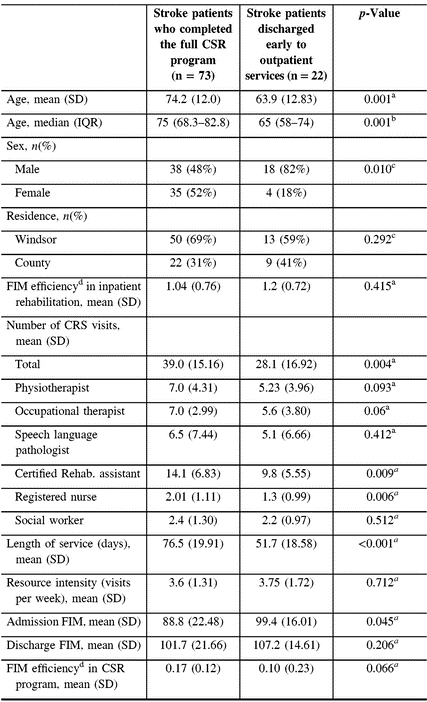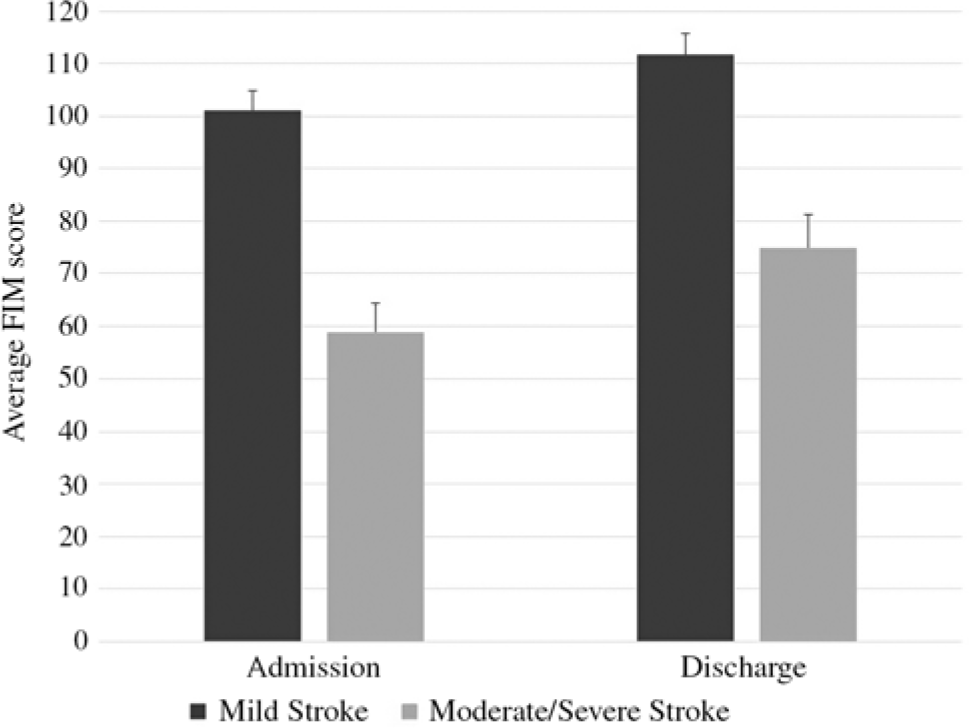Canadian stroke best practice guidelines indicate that stroke survivors should receive outpatient or community-based rehabilitation services within 72 hours following hospital discharge, when it is deemed necessary.Reference Hebert, Lindsay and McIntyre1 However, access to outpatient rehabilitation services may be limited for certain patients due to factors such as geography, transportation, or the level of functional impairments, as it requires the patient to travel from home to an outpatient facility.Reference Langstaff, Martin and Brown2 Furthermore, Ontario stroke survivors wait a median of 10 days for outpatient occupational therapy (OT) services, and 21 days for outpatient physiotherapy (PT) services depending on the region,Reference Passalent, Landry and Cott3 which can result in a loss of functional gains made during inpatient rehabilitation.Reference Hebert, Lindsay and McIntyre1
Stroke severity can also play a key role in access to rehabilitative services.Reference Pereira, Foley and Salter4 Best practice recommends that all individuals with moderate and severe impairment due to stroke have equitable access to inpatient rehabilitation; however, in practice, access can often be limited due to greater severity being associated with poorer prognosis and reduced capacity to recover functional independence compared to those who have experienced less severe deficits.Reference Pereira, Ross Graham and Shahabaz5 However, research shows that moderate and severe stroke patients can greatly benefit from inpatient rehabilitation services, resulting in decreased mortality rates and increased likelihood of discharge home.Reference Pereira, Ross Graham and Shahabaz5 Pereira et al.Reference Pereira, Ross Graham and Shahabaz5 suggest that following inpatient rehabilitation, particularly in the absence of a caregiver, additional community support is essential to facilitating patients with greater disability due to stroke returning home; however, guidance on where and how that support should be delivered is currently limited.
The need for community-based stroke rehabilitation services in the Windsor Essex County (WEC) region in Ontario, Canada, for individuals living with stroke is well documented. Thirty-four percent of WEC residents have difficulty in accessing health services, with a lack of transportation identified as the primary barrier.6 This is notably prevalent in the county regions outside of Windsor, as these residents do not have access to reliable or accessible public transportation.6 Moreover, stroke patients in the WEC region discharged from an acute care or inpatient rehabilitation stay receive on average 5.4 homecare visits, well below the provincial benchmark of 12.4,Reference Hall, Kahn and Levi7 leaving a large gap in post-hospital rehabilitation care.
A recent community stroke rehabilitation (CSR) model of care involving comprehensive, multidisciplinary, specialized stroke services provided at a patient’s home has emerged as an effective and viable alternative to traditional outpatient rehabilitation.Reference Allen, Richardson and McIntyre8, Reference Allen, McIntyre and Janzen9 Specifically, home-based stroke rehabilitation programs are associated with decreased length of stay and readmissions,Reference Langstaff, Martin and Brown2 reduced caregiver burden, decreased anxiety and depression, and improved functional ability that is sustained up to six-month post-discharge.Reference Allen, Richardson and McIntyre8 A CSR program delivered in London, Ontario, was shown to be an accessible, timely, and effective alternative to hospital-based outpatient services that eliminates barriers to post-inpatient rehabilitation.Reference Allen, Richardson and McIntyre8, Reference Allen, McIntyre and Janzen9 However, home-based CSR in Canada is still in its infancy; therefore, studies examining the effectiveness of these programs in supporting stroke patients’ continued recovery in the community following inpatient rehabilitation services and whether different subgroups of stroke patients benefit from this approach are warranted.10 This brief communication examines preliminary findings from the CSR program delivered by Hôtel-Dieu Grace Healthcare (HDGH) in Windsor, Ontario, and provides evidence for the benefits of delivering a CSR model as an approach to transition individuals with a range of functional deficits home successfully following inpatient rehabilitation.
A home-based CSR program developed in consultation with the South West LHIN CSR teamReference Allen, Richardson and McIntyre8 was delivered by HDGH, a tertiary hospital in Windsor, Ontario, Canada, to stroke patients following an inpatient rehabilitation stay. Eligibility criteria to the HDGH CSR program included: (a) the individual faced significant barriers (i.e., lack of transportation, low functionality) to regular attendance of outpatient rehabilitation; (b) the patient’s projected wait time for intake to outpatient services was deemed unacceptably long for their specific needs; and (c) the patient’s rehabilitation goals were deemed realistic for a home-based program. Patients were additionally referred to the CSR program based upon clinical recommendation from a consulting physiatrist. The CSR team included one physiotherapist, one occupational therapist, one speech language pathologist, one registered nurse, one social worker, and three certified rehabilitation assistants. The number of discipline-specific visits each patient received was dependent on their individual needs and rehabilitation goals. Targeted length of service for program patients was set at 12 weeks; however, prior to completing the program, 22 CSR patients were bridged to outpatient rehabilitation once their physical function improved to enable the transition.
The Functional Independent Measure (FIM®) was utilized to assess patient functional abilities at admission upon intake into the CSR program and again at discharge.Reference Keith, Granger and Hamilton11 The FIM® has previously been utilized as a valid and reliable method to evaluate CSR program outcomes.Reference Allen, Richardson and McIntyre8 FIM® scores were collected by CSR staff upon the first (admission) and last (discharge) visits, and entered into a program database by a CSR team member. Differences in patient’s length of service resulted in variable time between admission and discharge FIM® assessment. Stroke severity was defined based on individuals’ FIM® score at admission to the programReference Teasell, Hussein and Foley12 (mild stroke = FIM® >80; moderate stroke = FIM® 40–80; severe stroke = FIM® <40). After completing their inpatient rehabilitation stay, few patients had severe functional deficits upon admission to the CSR program and were therefore grouped together with the moderate stroke group. Data were collected from August 2016 to February 2018. Differences between patients who completed the CSR program and those who were bridged to outpatient rehabilitation, and between mild and moderate/severe stroke patients on demographic characteristics, resource intensity, length of service, and functional outcomes were examined using independent samples t-tests or Mann–Whitney U tests and chi-square or Fisher’s exact tests, where appropriate. Paired samples’ t-tests were used to assess changes in functional outcomes between admission and discharge for patients who completed the full CSR program. A repeated measures analysis of covariance (RM ANCOVA) was further applied to examine differences in functionality from admission to discharge between stroke severity subgroups, adjusting for age and resource intensity. This study was approved by the University of Windsor Research Ethics Board.
Between August 2016 to February 2018, 95 stroke patients were discharged from the CSR program. Of these patients, 73 were discharged after completing the full CSR program and 22 patients were discharged early to facility-based outpatient rehabilitation once their physical function improved to enable the transition. Table 1 describes patient and program characteristics for this group relative to patients who completed the CSR program. In particular, patients that were bridged to the outpatient program were significantly younger, more likely male, and had greater functional ability at the outset of the CSR program compared to patients who had completed the full program. However, given the focus on evaluating the full in-home CSR program, patients who were transitioned to outpatient services were excluded from further analysis.
Table 1: Patient and program characteristics for CSR program patients discharged early to outpatient services compared to patients who completed the full CSR program

p-Values <0.05 were considered statistically significant. ap-Value determined by a independent samples t-test, moderate vs. severe stroke; bp-value determined by a Mann–Whitney U test; cp-value determined by a chi-square test or Fisher’s exact test, where appropriate; dFIM efficiency is defined as change between admission and discharge FIM divided by length of service.
The mean age of patients who completed the program was 74 years old. These patients were enrolled in the home-based CSR program for an average of 76.5 days and received an average of 3.6 visits per week. The majority of patients (73%) who completed the program were experiencing mild neurological impairment upon admission, whereas a smaller subgroup (27%) had either moderate or severe disability due to stroke. A complete breakdown of patient and program characteristics stratified by stroke severity can be found in Table 2.
Table 2: Patient and program characteristics of the CSR program, by stroke severity group

Excludes stroke patients who were discharged early in order to transition to hospital outpatient rehabilitation program (n = 22). p-Values <0.05 were considered statistically significant. ap-Value determined by a independent samples t-test, moderate vs. severe stroke; bp-value determined by a Mann–Whitney U test; cp-value determined by a chi-square test; dFIM efficiency is defined as change between admission and discharge FIM divided by length of service.
Overall, patients who completed the program showed a statistically significant increase in functional ability (FIM change = 12.9 points; p = 0.000) from admission (88.8) to discharge (101.7). When stratified by stroke severity, both the mild (p = 0.000) and moderate/severe (p = 0.000) stroke patients demonstrated significant functional improvement post-discharge from CSR and no significant differences in resource intensity between subgroups were observed. A significant interaction between stroke severity and functional improvement from admission to discharge was observed (p = 0.020, η 2 = 0.08; Figure 1). Specifically, the moderate/severe stroke subgroup experienced on average greater functional gains (FIM change = 16.2) compared to the mild stroke subgroup (FIM change = 10.4) during the CSR program, after adjusting for age and resource intensity.

Figure 1: Interaction between stroke severity and functional improvement from admission to discharge from the CSR program, after adjusting for age and resource intensity, p = 0.020.
These preliminary results provide further evidence that home-based CSR is an effective approach for supporting individuals living with stroke to continue making functional improvement in the community following an inpatient rehabilitation stay. These findings are consistent with outcomes demonstrated by other CSR programs operating in neighboring regions.Reference Allen, Richardson and McIntyre8 Notably, results from this analysis appear to indicate that home-based CSR may be beneficial for successfully transitioning home individuals with moderate to severe functional deficits after inpatient rehabilitation. While the possibility exists that the larger improvements on the FIM seen by moderate/severe stroke patients may be due to a ceiling effect on part of the mild stroke patients, these results nevertheless indicate that CSR may be an effective method to facilitate discharge home and provide continued stroke care for persons still experiencing a moderate to high degree of functional disability after inpatient rehabilitation. Although moderate/severe stroke patients had a longer length of service and a greater number of total visits compared to mild stroke patients, these patients were still on average within the 12-week program target and no significant differences in resource intensity were identified suggesting that resource utilization was similar between groups.
It should be noted that these data were collected primarily for clinical purposes with multiple clinicians, inherent limitations exist with the accuracy of the data, and should be considered when interpreting results. Furthermore, these results are still preliminary and follow-up data are currently being collected to determine the long-term benefits of CSR for stroke patients in WEC, including an assessment of program cost and the logistical challenges associated with delivery. However, these preliminary results are a positive indication of the effectiveness of CSR for a range of stroke patients and may be considered by other CSR teams when assessing the suitability of program patients and conducting discharge planning for their programs.
Disclosures
The authors have no conflicts of interest to disclose.
Statement of Authorship
All authors made substantive contributions to the manuscript, including participation in the conception and design of the work reported in the manuscript (JP, SB, SM, & MJ), data analysis and interpretation (JV, MM, JP, & NRL), and drafting the manuscript (JV & MM). All authors contributed equally in providing critical revision, editing, and final approval of the manuscript.







